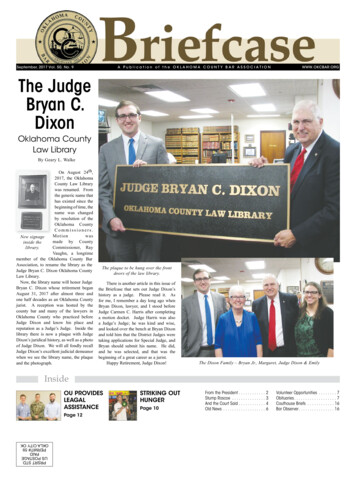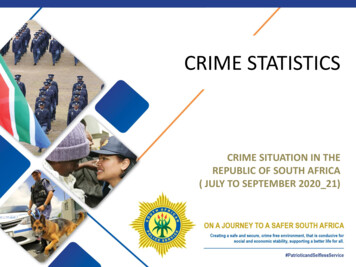
Transcription
September, 2017 Vol. 50, No. 9A Publication of the OKLAHOMA COUNTY BAR ASSOCIATIONWWW.OKCBAR.ORGThe JudgeBryan C.DixonOklahoma CountyLaw LibraryBy Geary L. WalkeOn August 24th,2017, the OklahomaCounty Law Librarywas renamed. Fromthe generic name thathas existed since thebeginning of time, thename was changedby resolution of theOklahoma CountyCommissioners.MotionwasNew signagemade by Countyinside theCommissioner, Raylibrary.Vaughn, a longtimemember of the Oklahoma County BarAssociation, to rename the library as theJudge Bryan C. Dixon Oklahoma CountyLaw Library.Now, the library name will honor JudgeBryan C. Dixon whose retirement beganAugust 31, 2017 after almost three andone half decades as an Oklahoma Countyjurist. A reception was hosted by thecounty bar and many of the lawyers inOklahoma County who practiced beforeJudge Dixon and know his place andreputation as a Judge’s Judge. Inside thelibrary there is now a plaque with JudgeDixon’s juridical history, as well as a photoof Judge Dixon. We will all fondly recallJudge Dixon’s excellent judicial demeanorwhen we see the library name, the plaqueand the photograph.The plaque to be hung over the frontdoors of the law library.There is another article in this issue ofthe Briefcase that sets out Judge Dixon’shistory as a judge. Please read it. Asfor me, I remember a day long ago whenBryan Dixon, lawyer, and I stood beforeJudge Carmen C. Harris after completinga motion docket. Judge Harris was alsoa Judge’s Judge; he was kind and wise,and looked over the bench at Bryan Dixonand told him that the District Judges weretaking applications for Special Judge, andBryan should submit his name. He did,and he was selected, and that was thebeginning of a great career as a jurist.Happy Retirement, Judge Dixon!The Dixon Family – Bryan Jr., Margaret, Judge Dixon & EmilyInsideOU PROVIDESLEAGALASSISTANCEPage 12STRIKING OUTHUNGERPage 10From the President . . . . . . . . . . . . 2Stump Roscoe . . . . . . . . . . . . . . . 3And the Court Said . . . . . . . . . . . . 4Old News . . . . . . . . . . . . . . . . . . . 6Volunteer Opportunities . . . . . . . . 7Obituaries . . . . . . . . . . . . . . . . . . . 7Couthouse Briefs . . . . . . . . . . . . 16Bar Observer . . . . . . . . . . . . . . . . 16PRSRT STDUS POSTAGEPAIDPERMIT# 59OKLA CITY OK
2 BRIEFCASE September 2017BRIEFCASESeptember 2017Briefcase is a monthly publication of theOklahoma County Bar Association119 North Robinson Ave.Oklahoma City, OK 73102(405) 236-8421Briefcase CommitteeJudge Jim Croy, Chris Deason, Ryan Dean, BenGrubb, Justin Hiersche, Scott Jones, Matt Kane,Travis Pickens, Liz Oglesby,Miles Pringle, AustinReams, Cari Remillard, Teresa Rendon, RexTravis, Collin Walke, Judge Geary Walke, JudgeAllen Welch and Alisa WhiteCo-editorsJoi Miskel& Shanda McKenneyContributing EditorsMichael BrewerRichard GoralewiczBill GordenWarren JonesKieran D. MayeOklahoma County Bar AssociationOFFICERS:PresidentPresident-ElectVice PresidentPast PresidentTreasurerBar CounselDavid CheekJudge Sheila StinsonMichael BrewerJudge Barbara SwintonRobert D. NelonCoree StevensonSTAFF:Executive DirectorLegal Placement DirectorMembership ServicesDebbie GordenPam BennettConnie ResarJournal Record Publishing Co. Inc.Special Projects SupervisorKady WeddleFor advertising information,call 278-2820.Postmaster: Send address changes to OCBABriefcase, 119 North Robinson Ave., OklahomaCity, Oklahoma 73102.Journal Record Publishing produces the Briefcasefor the Oklahoma County Bar Association, which issolely responsible for its content. 2014 Oklahoma County Bar AssociationOKLAHOMA COUNTY BARASSOCIATIONMISSION STATEMENTVolunteer lawyers and judges dedicatedto serving the judicial system, their profession, and their community in order to fosterthe highest ideals of the legal profession, tobetter the quality of life in Oklahoma County,and to promote justice for all.From the PresidentI Am Your OCBA Presidentby David A. CheekFor those that donot know me, and forthose that have notseen me in some time,let me explain who Iam and why I soughtthis position.I started practicinglaw in 1974. I went to law school becausemy father and his father were both lawyers. It was the thing to do. I was married, had one child and little money. Ineeded a job, and there was a family lawfirm that I presumed would hire me. Easydecision, right?Wrong! After “interviewing” withother members of my father’s firm, itbecame clear that the environment of thatfirm was not right for me. I rememberlooking at the portrait of my grandfather looking down on me as I exited the“interview” and thinking, “Is this reallythe right place for me?” My grandfathermoved his family from Tennessee at theturn of the century after giving up a teaching job. He did not go to law school and“wrote onto” the bar. His bar certificatehangs on my office wall today to remindme of that achievement.I concluded that I needed to lookaround for other opportunities. I wasfortunate enough to cross paths withMartin Stringer, Ken McKinney and KenWebster. They took a chance and hireda young, naïve and broke lawyer with ayoung family to support. We practicedtogether for 30 plus years, until other considerations sent us in other directions. In2005, I started Cheek & Falcone, PLLCwith other partners and I am still practicing there.I worked long hours initially for themoney (they paid more than the familybusiness offered). I focused hard on thelegal issues and clinical facts to get thecorrect result. It was profitable, but nototherwise rewarding.As I matured professionally, I began tolearn (often the hard way) that if I listenedto the client’s needs and desires, it wassometimes possible to fashion a strategythat resulted in a desired result withouta long extended (and expensive to theclient) litigation war. I began to make adifference and clients showed appreciation. That appreciation was displayed byprompt payment of invoices, and personalgestures that have taken numerous formsduring the years, including repeat business and referrals. For me, it meant jobsatisfaction.I had an experienced lawyer tell meearly in my career, that if I took care ofthe profession, the profession would takecare of me. At the time, I did not understand. Once I realized that this professionwe are in is not measured in billable hoursor perfect results, but should be morefocused on solving the client’s problemsas efficiently as possible, I began tounderstand what the experienced lawyerwas telling me.I have been blessed with “clients” whoThe David Cheek Family Reunion -- Spring 2017have become friends, who regularly seekmy advice and are glad to pay a reasonable fee for that advice. In the process, Ihave learned about businesses, personalneeds, goals, and desires of clients. I liketo think my current advice is less clinicaland more “sage”. Also in the process, Ihave made a really good living. It is timeto give back.The County Bar is a place where givingback takes center stage in multiple ways,multiple venues and shows cases the positive side of the practice of law at work ona daily basis.I have inherited an institution run bya staff of super qualified people. It isn’tbroke, so I do not intend to “fix it”, but Ido hope to explore minor improvements.Membership has been declining. Wecurrently represent approximately 30% ofthe lawyers in Oklahoma County. I hopeto explore ways to increase memberships,with an emphasis on diversifying thememberships. I have some ideas thatI will be exploring with the Board. Iencourage you to share any ideas youhave with the new Board of Directors.For now, I would like to thank you foryour vote of confidence in electing me. Iwill try not to disappoint you.I N - PA P E R S E C T I O N : D E C E M B E R 7, 20172018O K L A H O M A C I T Y’S B E S T L AW YE R SOn December 7, the OklahomaJournal Record will publish a specialin-paper section that will recognizeOklahoma City’s Best Lawyers .Published exclusively in OklahomaCity by the Journal Record, this sectionwill identify attorneys who havebeen selected, through a peer-reviewmethodology, to be on the list of theBest Lawyers in America 2018.DEADLINESSpace Reservation:November 17, 2017Camera-Ready Deadline:November 27, 2017Publication Date:December 7, 2017Contact us to reserve your ad space today!For more information, contact your account manager at (405) 278-2830or the director of advertising, Sarah Barrow at sbarrow@journalrecord.com.
www.okcbar.org September 2017 BRIEFCASE 3Stump RoscoeSTUMP ROSCOEByRoscoe X. PoundDear Roscoe: What started out indivorce court in a custody battle hassince found its way to juvenile court, theCourt of Civil Appeals, and both municipal and civil criminal dockets. Recently,my client suffered a heart attack from thestress. We’ve been playing defense allalong. Given that he has had to defendhimself against two criminal chargesas well as a boatload of civil litigation,it has become obvious she is using thejudicial system as a club to beat him todeath. Would that be enough for a civilrights complaint? BT, Warr Acres, OK.Dear BT: Remember when we werekids and used to hear our parents saystuff like: “OK. You don’t have to makea federal case out of it.” Well, if you’vepracticed long enough you probably havefound, among other things that it’s not aseasy to make a federal case out of something as you once thought.Private individuals generally are notconsidered to act under color of law,”Ballard v. Wall, 413 F.3d 510, 518 (5thCir. 2005), but “private action may bedeemed state action when the defendant’s conduct is ‘fairly attributable tothe State” if deprivation was causedby the exercise of some right or privilege created by the state or by a ruleof conduct imposed by the state, or bya person for whom the state is responsible, and that the party charged withthe deprivation may fairly be said to bea state actor. One way to do this is toestablish a conspiracy or joint activityso that the private person’s wrongful actscan be attributed to the State. Evidencethat a private citizen reported criminalactivity or signed a criminal complaintdoes not suffice to show state action onthe part of the complainant in a falsearrest case. The plaintiff must further“show that the police in effecting thearrest acted in accordance with a ‘preconceived plan’ to arrest a person merelybecause he was designated for arrest bythe private party, without independentinvestigation.” Your question does notprovide enough specificity to say whetheran independent investigation as to thecharges was made. In addition, thereneeds to be some evidence of action inaid of a preconceived plan. This is not adifficult standard for a defendant to meet.It becomes particularly difficult for theplaintiff if, for example, the accused hadbeen bound over, an ADA independentlyreviewed and agrees to the charges, orwhere a judge found probable cause toissue an arrest warrant.This is not to say that other torts maynot have occurred but, based on whatyou’ve given me, I wouldn’t try to make afederal case out of it.Dear Roscoe: Two part question: Doesthe failure of a judge to gain reelectionmoot a disciplinary proceeding underthe Code of Judicial Conduct? Can adisciplinary body “tack on” the judicialcomplaint acts which occurred in privatepractice? KM, OKC.Dear KM: Talk about cutting edge,the Supreme Judicial Court of Maineaddressed these issues earlier this summer in In re Nadeau. In that case, a disciplinary panel a condition suspension.On appeal, the Supreme Judicial Courtupgraded the sanction to an absolute twoyear suspension. Nadeau sought rehearing that, because he did not seek reelection and returned to private practice,the judicial disciplinary proceeding wasmoot. The Court rejected this argument,citing prior decisions of which Nadeau,as both judge and lawyer should haveknown. In essence, the court held thatsanctions could carry over to his privatepractice as he remained a member ofthe Bar, and subject to the court’s disciplinary power. As to the issue of “tacking”, the court didn’t specifically use thatterm. It did note, however, that recordsgoing back to 1980 show that no otherattorney had been referred to the courtfor disciplinary proceedings than Mr.Nardeau. There followed a summary ofthis actions, cataloguing his prior indiscretions and the lesser sanctions whichapparently lacked corrective effect. Oneof many takeaways: The evil we do tendsto live on, and the reputation we lose ishard to regain.***Well, this summer’s fi shing wasgreat and I once again have a garagefreezer filled to capacity with bluefish. Fortunately, they don’t last longaround here, particularly during the LastWeekend of Summer Bash I usuallythrow at my place. I’d send you all aninvite, but even a seafood junkie like memight not make a 1400 mile pilgrimagefor what promises to be the best fish,PLANNING YOUR WEDDINGRather than RentingRECEIVE 100 off your PURCHASEof a NEW WEDDING SUITFor Wedding Parties of 4 or MoreTUXEDO RENTALS AVAILABLETEENA HICKS COMPANYOKLAHOMA TOWER 210 PARK AVENUE, SUITE 220OKLAHOMA CITY, OK 73102(405) 235-4800Go Like us on c TEENA HICKS COMPANYcrab, and slaw on the Eastern Seaboard.I forced myself into motion, and setout for the office. The calendar showedeveryone to be where he or she shouldbe, I tuned my radio to The Bridge, andbegan sorting through the accumulatedmail, both of the electronic and the snailkind. I weeded the pure junk out, andmade it about halfway through the restwhen the phone buzzed.“Mr. P.,” said Rae, “it’s Lt. Orensteinon 3.”I punched the extension to life.“Roscoe, this is Buddy you need to getover to St. Mary’s.”“St. Mary’s what?” I asked. ““Hospital. ER. They’re wheeling inFather Auggie.”I felt my stomach turn cold and drop.“What happened?”“Talk to ya when you get here.”He hung up. I made the trek toHoboken in what probably would turnout to be record time. I arrived at thehospital without really remembering thedrive. I parked and made my way toEmergency at a jog, pausing only at theinsistence of the traffic. Buddy Orensteinand a uniformed officer stood in thewaiting area chatting with a paramedic.The patrolman took notes. I hesitated,not wanting to break in on the debriefing.Eventually, the detective saw me andwaved me over.“What’s the word?” I asked.“Bad,” he answered. “Looks likeAuggie drew the milkman’s service thisweek. Left after the Mass, after thealtar boys had gone. Don’t know who,or how many, but he took a beat down.Father Thad came to look for him, andfigured he might have wandered overto the school or a store. Then he foundhim unconscious down in the exteriorstairwell that leads to the church basement. Auggie’s keys were out and on theground next to him.”“Meaning?”“Apparently the good Father fellback of the streetfighter and GoldenGloves days of his youth. We founda tooth up on the lawn, and the keyshave blood on them, indicating he usedthem between his fingers as a makeshiftweapon. His knuckles were scraped andbleeding and he may have even administered a head butt or two. He didn’t godown easy.”“He wouldn’t,” I said. What’s hiscondition?”“Not sure yet. Probable concussion.A coupla broken ribs. Also bite marks. Ifigure multiple assailants who continuedto beat on him even after he was downand out. They also left a note:“Why stir up trouble that will onlybring disaster on you and the peple ofJudah?”“Sounds Biblical,” I said“It is,” said Buddy, “Second Kings.”I looked at him, somewhat surprised.He shrugged. “It’s one of ours,” heremarked.“But what does it mean here?” Ianswered.Buddy shrugged. “I’m just a humblecivil servant. You’re the guy who dealswith the stumpers.”Quote of the MONTH“Dance like no one is watching; email like you’ll be reading itin a deposition someday.”—Jim Calloway, Oklahoma Bar Association ManagementAssistance Program Director (1956-)
4 BRIEFCASE September 2017And The Court SaidAn Olio of Court ThinkingAnd the Court Said .A n O liO Of C Ourtt hinkingby Jim CroySeptember 15, 1917One Hundred Years Ago[Excerpted from: Lewis v State,1917 OK CR 226, 174 P. 1094.]The plaintiff in error, G.A.Lewis, was convicted in the districtcourt of Bryan county on a chargeof assault with intent to kill, and hispunishment fixed at imprisonment inthe state penitentiary for one year. Theinformation charges the plaintiff inerror with shooting his wife, SydneyLewis, with a pistol, in Durant, inBryan County, Okla., on the 13th dayof March, 1915.It appears from the evidence thatthe plaintiff in error and his wife hadseparated; that divorce proceedingswere pending in the district courtof Bryan county; that counsel hadadvised the accused that the result ofhis divorce suit depended largely uponthe conduct of his wife; that he waswatching her, and upon the night inquestion went from his home in thenorthwest part of the city of Durantto the business district to buy somegroceries, and from the grocery storewent to the Union depot; that he wasarmed with a pistol; that he saw hiswife, Sydney Lewis, a Mrs. Moody,and two men walking on the platform,on the south side of the depot, goingwest; that he stood in the shadow nearthe west end of the depot, and as theparties approached from the east firedthree shots.The testimony on behalf of thestate tends to establish that the accusedshot at his wife and wounded herseriously; that another shot hit one ofthe men; that Mrs. Moody and Mrs.Lewis were walking together; thatthe men were some few feet ahead ofthem; that neither of the four partiessaid or did anything to provoke theplaintiff in error. On his own behalf,the accused testified that one of themen, named Rowsey, was attemptingto shoot him, as he thought, and that heshot at Rowsey in self-defense, and didnot shoot at his wife. He testified thatRowsey had hold of his wife’s arm.Rebuttal on behalf of the state refutedthese statements, and also showed thatRowsey at the time of the shooting wasunarmed. In fact, it is very clear fromthe record that the parties never sawthe plaintiff in error until he was in theact of firing on them. After he firedthe shot he ran away, hid the pistol,and when arrested pretended to knownothing about the transaction.There are only two propositionsurged in the brief. The first is basedupon the contention that the court erredin refusing to admit certain testimonyoffered by the plaintiff in error to theeffect that he had had trouble with hiswife prior to their separation, in whichshe had attempted to assault him. Theplaintiff in error testified to these factshimself, and offered members of hisfamily — children by his first wife —to substantiate them. Counsel contendthat this testimony was competent forthe purpose of showing the ill feelingexisting between the parties and tosupport the testimony of threats said tohave been made by Mrs. Lewis, whichhad been testified to in his behalf.We are unable to conclude thatthis was error. The plaintiff in errorhimself testified that he did not shootat Mrs. Lewis, but shot at Rowsey;that he was not attempting to injureher. Ill feeling, therefore, between thetwo would not have been material tohis defense, which was the contentionthat he shot at Rowsey in self-defense.Even though the testimony contendedfor was admissible, it would not besufficient to reverse this judgment, forthe reason that the plaintiff in errorhimself testified to all the facts, and noone denied them. It is very clear fromthe record that nobody was harminghim, or attempting to do so. He was amean and jealous husband, who wasseparated from his wife, and was eithershooting at her with intent to kill, orshooting with a reckless disregard forothers, without provocation in law.September 29, 1942Seventy-Five Years Ago[Excerpted from In re Cabaniss’Estate, 1942 OK 311, 129 P.2d 1003.]William F. Cabaniss died testateand his will was duly admitted toprobate. The second paragraph of thewill is as follows:“Second: To my wife AdaCabaniss I will and bequeaththe home place which containsone hundred forty-five acres orabout, until her death or untilshe marries again. This doesnot include any live stock.”The will contained several specificdevises and bequests, and a residuaryclause in favor of his three sons and onedaughter. After the will was executedAda Cabaniss secured a divorce fromtestator together with judgment foralimony, which was paid. About twomonths after the divorce decree wasentered William F. Cabaniss diedwithout having changed his will. Thewill was duly admitted to probate, andthereafter Ada Cabiness filed petitionfor distribution to her of the propertycovered by the clause in the willabove quoted Two of the residuarydevisees filed objections to the saidpetition on the ground, among others,that the divorce had the effect ofrevoking the provision in favor of AdaCabaniss. From an order overrulingthe objections thereto and sustainingthe petition, the objecting deviseesappealed to the district court.***The first question presented isthis: Is a provision in a will made byone spouse in favor of the other spouserevoked by the subsequent divorceof the parties in which the devisee isawarded and collects judgment foralimony? We think this question mustbe answered in the negative.84 O. S. 1941 § 101 provides:“Except in the cases in this articlementioned no written will, nor anypart thereof, can be revoked or alteredotherwise than: . . .”The section then provides that awill may be revoked by the testator byanother instrument properly executed,or by being burnt, torn, canceled,obliterated, or destroyed. The next fivesections of the statute elaborate on themethods of revocation by the positiveacts of the testator as provided insection 101. Section 107 provides that,with certain exceptions, the subsequentmarriage, or the subsequent marriageand birth of a child as a result of suchmarriage, revokes the will. Section108 provides that a will executed byan unmarried woman is revoked byher subsequent marriage. Our statutesmake provision for the revocation of awill by operation of law in only the twoinstances indicated. Many states havestatutes containing a general provisionfor the revocation of wills “impliedby law from subsequent changes inthe condition or circumstances of thetestator,” or similar provisions . . . butour statute contains no such provision.Section 101 of our statute, above,contains no ambiguity. It makes thespecified methods of revocationexclusive. Such was the holding ofthis court in the case of In re Ballard’sEstate, 56 Okla. 149, 155 P. 894. TheCalifornia statute is identical withour section 101, and in the case of Inre Comassi’s Estate, 107 Cal. 1, 40P. 15, it was held that the statutorymethods of revocation are exclusiveand abrogate the doctrine of impliedrevocation except as is provided bystatute. It is true that the CaliforniaCode contains an additional provisionthat “a written will cannot be revokedor altered otherwise than as providedin the Civil Code,” yet we think suchprovision adds nothing to section 101,above. It merely expresses in differentlanguage the thought expressed insection 101.What we have said is in accordwith the general rule that, when astatute provides the manner in whicha will may be revoked, the statutorymethod is exclusive. . . .It is intimated in the brief of theappellants by the fact that the devisewas “to my wife Ada Cabaniss” thetestator did not intend the devise toAda Cabaniss if she ceased to be hiswife. There is no provision in the willto the effect that she should not takethe devise if she ceased to be his wife.We are of the opinion, and hold, thatthe use of the term “my wife” is merelydescriptive of the person and was notintended as a limitation upon the rightof Ada Cabaniss to take. . . .Appellants further contend that12 O. S. 1941 § 1279 precludes theappellee from claiming an interestin testator’s estate, but they cite noauthorities to support such contention.That section provides:“A divorce granted at the instance ofone party shall operate as a dissolutionof the marriage contract as to both, andshall be a bar to any claim of eitherparty in or to the property of the other,except in cases where actual fraudshall have been committed by or onbehalf of the successful party.”The section has to do with claimsthat one spouse may have and enforceagainst the property of the other byreason of the marriage relation, andhas nothing to do with the right ofa legatee or devisee to claim undera will, though the testator may havebeen a former husband or wife of adevisee or legatee. 84 O. S. 1941 §45 specifies the persons capable oftaking property by will, and it doesnot prohibit a divorced spouse from sotaking.Fifty Years AgoSeptember 13, 1967[Excerpted from Davis v. Page,1967 OK CR 150, 431 P.2d 951.]This is an original proceedingwhereby petitioner seeks his releasefrom the penitentiary by filing anapplication for writ of habeas corpus.He contends that he was misled bythe county attorney and entered a pleaof guilty in exchange for a promiseof an 18 months sentence. When heentered his plea before the trial judge,a sentence of 7 years was imposed, thelast 5 of which was suspended upongood behavior. The record before usreflects that petitioner was chargedwith “Obtaining Money Under FalsePretenses” in Pontotoc County. Thecharge arose out of a scheme bypetitioner whereby he was obtainingmoney from lawyers to obtainfictitious compensation cases for them.In other words, petitioner would callan attorney long distance, and advisethem he knew of a person who hadbeen hurt in a hazardous occupationand was entitled to compensation;and if said attorney would wire him 25.00 expense money, he would getthe injured party to hire said attorney.This, of course, created a precarioussituation — as the attorney would besubject to disciplinary action by theState Bar Association if the petitionertestified as to the facts involved.
www.okcbar.org September 2017 BRIEFCASE 5No doubt, the state was mostanxious to work out some kind of adeal with petitioner rather than get theattorney involved.Petitioner was represented by W.B.Ward, Jr., a capable attorney fromAda, who has filed with this Courta statement wherein he negotiated adeal with the county attorney, FrancisMayhue, whereby petitioner wouldplead guilty and accept a sentence of18 months in the penitentiary. Uponthis promise of his attorney and thecounty attorney, he agreed to pleadguilty. Attached to the petition is astatement by Francis Mayhue, thethen county attorney, who verifiesthe transaction and states that thepetitioner agreed to withdraw his pleaof not guilty and plead guilty inexchange for a sentence of 18 months.However, as heretofore stated, whenpetitioner appeared before the trialjudge and withdrew his plea of notguilty and entered a plea of guilty,he was sentenced to 7 years in thepenitentiary, with the last 5 suspended.Petitioner testified that whensentence was pronounced, he wasshocked, and turned to his attorney andsaid “Do something”, and his attorneyreplied “Be quiet, we will take care of itlater”. The following August petitionerwas transported to the penitentiary atMcAlester. Nothing more was done inthe case. Petitioner served the 2 yearsand was released, as per the judgmentand sentence, to do the balance of 5years on the outside — pending goodbehavior. Petitioner was arrested inMidwest City on a charge of Drivingwhile Intoxicated. Thus, the DistrictJudge of Pontotoc County revokedhis suspended sentence, and petitioneris now in the penitentiary doing thebalance of the 7 years. Defendant hasserved approximately 37 months of thesentence, or twice as much time as hehad originally agreed to serve.A plea of guilty should be freelyand voluntarily given. It is not likelythat the plea entered in the case atbar was freely given where there wassuch a misunderstanding as to whatsentence would be imposed.In view of the county attorney’sstatement, we feel that petitioner hada right to rely upon his promise.Of course, he should have attemptedto withdraw his plea after he haddiscovered the sentence was not as hewas promised, but evidently he wasadvised to keep quiet, and it would betaken care of later.The State did not attempt to re-butthe facts as related by petitioner,therefore, the Court has no alternativebut to take them as true.We, therefore, are of theopinion that petitioner was denied afundamental right and justice wouldbe best served by considering thesentence as reduced to time served,and the petitioner be discharged fromhis imprisonment.It is hereby ordered that theWarden of the State PenitentiaryatM c A l e s t e r,Oklahoma,iscommanded to immediately releasepetitioner, William “Bill” Davis,#72762, from custody.August 11, 1992Twenty-Five Years Ago[Excerpted from Bechtel v. State,1992 OK CR 55, 840 P.2d 1.]Appellant defended this case on thetheory of self-defense. In Oklahoma,self-defense is the subject of statutoryand case law. The relevant portions of21 O.S. 1981 § 733 state:Homicide is also justifiablewhen committed by any personin either of the followingcases:2. When committed inthe lawful defense of suchperson, , when thereis a reasonable ground toapprehend a design to commita felony, or to do some greatpersonal injury, and imminentdanger of such design beingaccomplished; . . . .This Court has held that the barebelief that one is about to suffer deathor great personal injury will not, initself, justify taking the life of hisadversary. There must exist reasonablegrounds for such belief at the timeof the killing. (Emphasis added).Further, the right to take another’slife in self-defense is not to be testedby the honesty or good faith of thedefendant’s belief in the necessity ofthe killing, but by the fact whether hehad reasonable grounds for such belief.See Hood v. State, 106 P.2d 271 (Okl.Cr. 1940). Fear alone never justifiesone person to take the life of another.Such fear must have been inducedby some overt act, gesture or wordspoken by the deceased at the time thehomicide occurred which would forma reasonable ground for the belief thatthe accused is about to suffer death orgreat bodily harm. McKee v. St
Oklahoma County Commissioners. Motion was made by County Commissioner, Ray Vaughn, a longtime member of the Oklahoma County Bar Association, to rename the library as the Judge Bryan C. Dixon Oklahoma County Law Library. Now, the library name will honor Judge Bryan C. Dixon whose retirement began August 31, 2017 after almost three and











